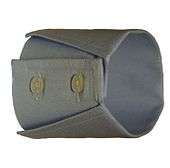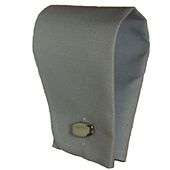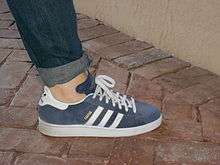Cuff



A cuff is an extra layer of fabric at the lower edge of the sleeve of a garment (shirt, coat, etc.) covering the arm, at the wrist. The function of turned-back cuffs is to protect the cloth of the garment from fraying, and, when frayed, to allow the cuffs to be readily repaired or replaced, without changing the garment. Cuffs are made by turning back (folding) the material, or a separate band of material can be sewn on, or worn separately, attached either by buttons or studs. A cuff may display an ornamental border or have lace or some other trimming. In US usage, the word trouser cuffs refers to the folded, finished bottoms of the legs of a pair of trousers.
Shirt cuffs
Except on casual attire, shirt cuffs are generally divided down one edge and then fastened together, so they can let a hand through and then fit more snugly around the wrist. Some sweaters and athletic garments (both tops and pants) have cuffs that either contain elastic or are woven so as to stretch around a hand or foot and still fit snugly, not accomplishing the same purpose.
Divided shirt cuffs are of three kinds, depending on how they fasten:
- Button cuffs, also called barrel cuffs, have buttonholes on the one side and buttons on the other (sometimes more than one, so that the fit can be adjusted).
- Link cuffs, which have buttonholes on both sides and are meant to be closed with cufflinks or silk knots. They are most commonly fastened in either the "kissing" style, where the insides of both sides are pressed together, or very unusually with the outer face touching the inner face, as with a button cuff (though this is unorthodox). Link cuffs come in two kinds:
- Single cuffs, the original linked cuff, are required for white tie and are the more traditional choice for black tie. Also, some traditionalists may wear this style with lounge suits as well.
- French, or double, cuffs, are twice as long and worn folded back on themselves. French cuffs were once considered to be more formal than button cuffs, although they are seeing a resurgence in the business environment, particularly in Europe. Even though traditionally French cuffs could only be worn with a lounge suit or more formal clothing (and not a sports jacket), this is now not followed by most, while some even wear these cuffs without a tie or jacket. They remain the preferred choice for semi-formal, black tie events.
- Convertible cuffs may be closed with buttons or with cufflinks.
Anatomy of the single or double cuff: The fabric is folded back onto itself, thus the inside of the shirt sleeve becomes the outside of the cuff and the outside of the shirt sleeve, becomes the inside of the cuff.
Trouser cuffs

Most trouser legs are finished by hemming the bottom to prevent fraying. Trousers with turn-ups ("cuffs" in American English), after hemming, are rolled outward and sometimes pressed or stitched into place. The functional reason for the cuffs is to add weight to the bottom of the leg, to help the drape of the trousers. Parents may also use cuffs to extend the life of children's clothes by buying pants that are too long, cuffing the leg and then unrolling it as the child grows. Originally, however, it started as men rolling up their trousers to avoid getting mud splashed on them when roads were still unpaved.
In the late 1980s and early 1990s, young people in some countries would tightly fold or roll the bottoms of their pants. Reportedly, this "tight-rolled pants" or "pegged pants" fad made a comeback in the 2010s, beginning in London.[1]
Jacket cuffs
The buttons and buttonholes at the end of suit jacket sleeves are generally decorative and non-functional. "Surgeon’s cuffs" can be opened at the wrist,[2] and are traditionally associated with bespoke tailoring.
References
- ↑ "Hot or not: Boys met opgerolde broekspijpen - Girlscene" (in Dutch). 2011. Retrieved 31 December 2013.
|first1=missing|last1=in Authors list (help) - ↑ Rosenbloom, Stephanie (February 13, 2009). "For Fine Recession Wear, $7,000 Suits From Saks (Off the Rack)". New York Times. Retrieved 2009-02-14.